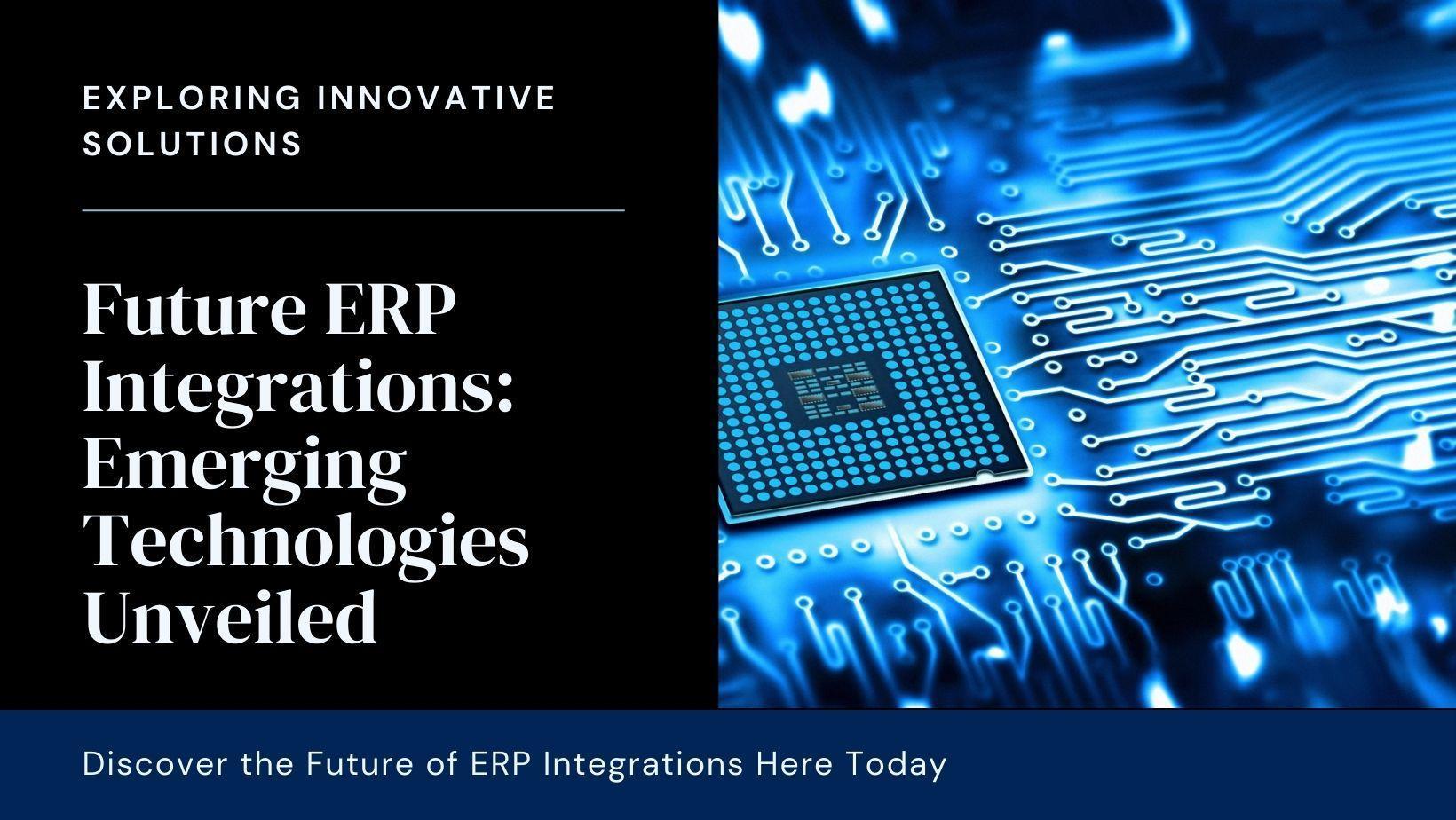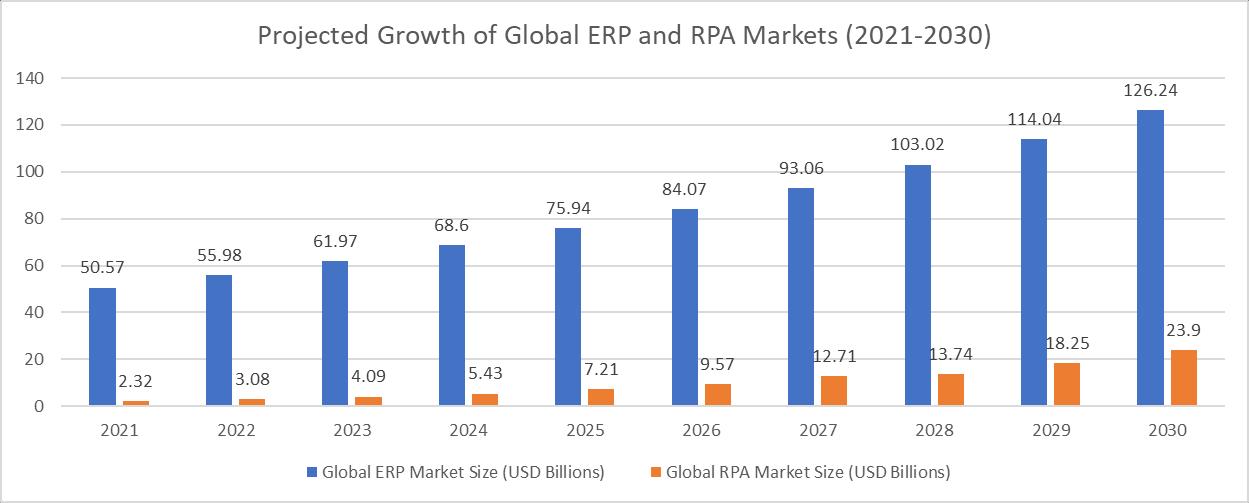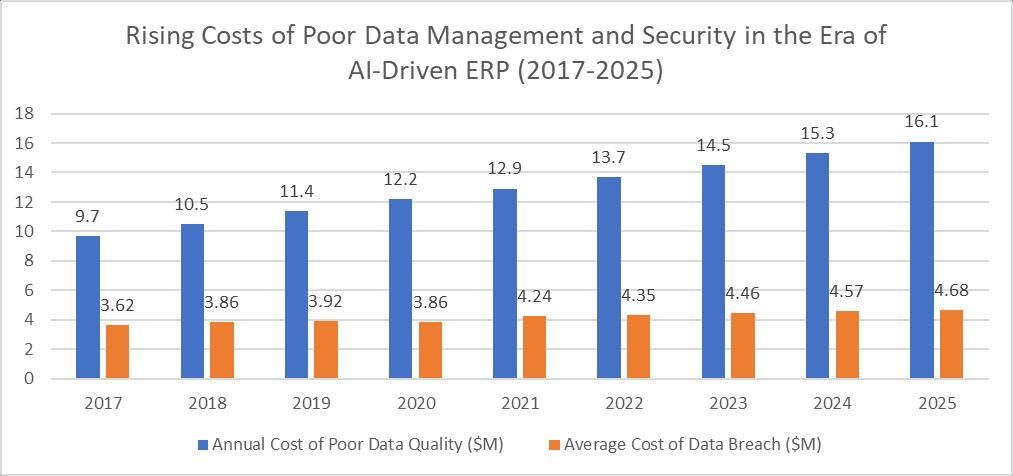
International Research Journal of Engineering and Technology (IRJET) e-ISSN:2395-0056
Volume: 11 Issue: 07 | July 2024 www.irjet.net p-ISSN:2395-0072


International Research Journal of Engineering and Technology (IRJET) e-ISSN:2395-0056
Volume: 11 Issue: 07 | July 2024 www.irjet.net p-ISSN:2395-0072
Hari Krishna Reddy Rikkula
Oracle,
USA

Abstract:
This article examines the evolving landscape of Enterprise Resource Planning (ERP) integrations, focusing on the impact of emerging technologies such as Artificial Intelligence (AI), Machine Learning (ML), and Robotic Process Automation (RPA). It exploresthecurrentstateofERPintegrations,highlightingchallengeslikecomplexmanualprocessesanddatasilos.Thepaper then delves into how AI, ML, and RPA are transforming ERP integrations, offering benefits such as intelligent data mapping, predictivemaintenance,andautomateddatamigration.Keychallengesinadoptingthesetechnologiesarediscussed,including data quality issues, skill gaps, and security concerns. The article concludes by proposing best practices for successful implementation, emphasizing the importance of pilot projects, training programs, strong governance, collaboration, and continuous optimization. This comprehensive overview provides organizations with insights to leverage emerging technologieseffectivelyintheirERPintegrationstrategies,drivingdigitaltransformationandoperationalefficiency.
Keywords: ERPIntegration,ArtificialIntelligence,MachineLearning,RoboticProcessAutomation,DigitalTransformation
Introduction:
Enterprise Resource Planning (ERP) systems have long been the backbone of organizational operations, integrating various businessprocessesintoaunifiedplatform.Aswemovefurtherintothedigitalage,thelandscapeofERPintegrationsisrapidly evolving, driven by emerging technologies such as Artificial Intelligence (AI), Machine Learning (ML), and Robotic Process Automation(RPA). Thisarticleexploreshowthesetechnologiesare reshapingERP integrations, their potential benefits,and thechallengesorganizationsfaceinadoption.

International Research Journal of Engineering and Technology (IRJET) e-ISSN:2395-0056
Volume: 11 Issue: 07 | July 2024 www.irjet.net p-ISSN:2395-0072
TheglobalERPmarketsizewasvaluedatUSD50.57billionin2021andisexpectedtoexpandatacompoundannualgrowth rate (CAGR) of 10.7% from 2022 to 2030 [1]. This growth is largely fueled by the increasing adoption of cloud-based ERP solutionsandtheintegrationofadvancedtechnologies.Accordingtoa recentsurveybyPanorama ConsultingGroup,64%of organizationsreportedintegrationissuesasasignificantchallengeintheirERPimplementations[2].
The integration of AI and ML in ERP systems is gaining momentum, with Gartner predicting that by 2025, 50% of ERP applicationswillutilizethesetechnologiestoimproveuserexperienceandautomateprocesses[3].Thisshiftisdrivenbythe potential of AI and ML to enhance decision-making, automate routine tasks, and provide predictive analytics capabilities withinERPecosystems.
RPAisanothertechnologytransformingERPintegrationsbyautomatingrepetitivetasksandstreamliningdataflowbetween systems.TheglobalRPAmarketsizeisprojectedtoreachUSD13.74billionby2028,growingataCAGRof32.8%from2021to 2028[4].ThisrapidgrowthisindicativeoftheincreasingroleRPAisplayinginmodernizingERPintegrationsandimproving operationalefficiency.
Asorganizationscontinuetoinvestintheseemergingtechnologies,theyfacebothopportunitiesandchallenges.Thepotential benefits include increased efficiency, improved data accuracy, and enhanced decision-making capabilities. However, challengessuchasdataqualityissues,skillgaps,andsecurityconcernsmustbeaddressedtofullyleveragethepowerofthese technologiesinERPintegrations.
This article will delve deeper into how AI, ML, and RPA are reshaping ERP integrations, explore their potential benefits, and discuss strategies for overcoming adoption challenges. By understanding these trends and their implications, organizations canbetterpositionthemselvestoleverageemergingtechnologiesanddrivedigitaltransformationthroughtheirERPsystems.

Traditional ERP integrations often involve complex, manual processes that can be time-consuming and prone to errors. A recent study by Panorama Consulting Group found that 64% of organizations reported integration issues as a significant challenge in their ERP implementations [5]. These challenges can lead to increased costs and decreased efficiency, with companiesspendinganaverageof5-15%oftheirtotalERPbudgetonintegration-relatedactivities[6].
The complexity of ERP integrations is further highlighted by a survey conducted by IDC, which revealed that 72% of organizations struggle with data silos across different systems, making it difficult to achieve seamless integration [7]. This fragmentationofdatanotonlyhampersoperationalefficiencybutalsoimpedesdecision-makingprocesses.

International Research Journal of Engineering and Technology (IRJET) e-ISSN:2395-0056
Volume: 11 Issue: 07 | July 2024 www.irjet.net p-ISSN:2395-0072
Moreover,thetimerequiredforERPintegrationprojectscanbesubstantial.AccordingtoareportbyMintJutras,theaverage timeforanERPimplementation,includingintegrationwithexistingsystems,is17months[8].Thisextendedtimelinecanbe attributed to the challenges in mapping business processes, data migration, and ensuring compatibility between legacy systemsandmodernERPplatforms.
The financial impact of integration challenges is significant. A study by Forrester Research found that organizations can lose upto$140,000peryearduetoproductivityissuescausedbypoorsystemintegration[7].Thislossisoftenaresultofmanual dataentryerrors,duplicatedata,andthetimespentreconcilinginformationacrossdifferentsystems.
Furthermore, the increasing adoption of cloud-based ERP solutions has introduced new integration challenges. While cloud ERPs offer benefits such as scalability and reduced infrastructure costs, they also require organizations to rethink their integration strategies. A survey by Oracle found that 59% of companies cite integration with existing systems as a major challengewhenmovingtocloud-basedERP[8].
As organizations continue to grapple with these integration challenges, there is a growing recognition of the need for more advanced,automatedintegrationsolutions.Thishasledtoanincreasedinterestinemergingtechnologies suchasAI,ML,and RPA,whichpromisetostreamlineintegrationprocessesandimproveoverallERPsystemfunctionality.
Challenge
AverageERPbudgetspentonintegration
(midpointof5-15%)
Annuallossduetopoorsystemintegration
CompaniescitingintegrationasamajorcloudERPchallenge
Table1:KeyChallengesinERPIntegration:StatisticsandImpacts[5-8]
Emerging Technologies in ERP Integrations
1. Artificial Intelligence (AI) and Machine Learning (ML)
AIandMLarerevolutionizingERPintegrationsbyintroducingintelligentautomationandpredictivecapabilities. Accordingto a report by Gartner, by 2025, 50% of ERP applications will utilize AI and ML to improve user experience and automate processes[9].TheglobalAIinERPmarketisexpectedtogrowataCAGRof32.5%from2021to2028,reaching$2.9billionby 2028[10].
KeybenefitsofAIandMLinERPintegrationsinclude:
● Intelligent Data Mapping: AI algorithms can analyze data structures and suggest optimal mapping configurations, reducingmanualeffortandimprovingaccuracy.AcasestudybySAPreporteda 40%reductionindatamappingtime for organizations using AI-assisted integration tools [11]. Additionally, IBM's Watson AI-powered data mapping solutionhasdemonstratedupto60%fasterdataintegrationprocessesforcomplexERPsystems[12].
● Predictive Maintenance: ML models can analyze historical data to predict system failures and maintenance needs, minimizing downtime and optimizing resource allocation. Research by McKinsey suggests that predictive maintenance can reduce machine downtime by up to 50% and increase machine life by 20-40% [13]. A study

International Research Journal of Engineering and Technology (IRJET) e-ISSN:2395-0056
Volume: 11 Issue: 07 | July 2024 www.irjet.net p-ISSN:2395-0072
published in the IEEE Transactions on Industrial Informatics found that ML-based predictive maintenance in ERP systemscanleadtoa30%reductioninmaintenancecostsanda70%decreaseinbreakdowns[14].
● Natural Language Processing (NLP): NLP capabilities enable more intuitive user interfaces and chatbots for ERP systems, simplifying integration processes and improving user adoption. A survey by Oracle found that 80% of businessesplantousechatbotsforcustomerinteractionsby2025[15].ImplementationofNLP-poweredchatbotsin ERPsystemshasshowntoreducesupportticketvolumebyupto30%andimprovefirst-callresolutionratesby25% [16].
Aspect
Table2:ImpactofAIandMLonERPIntegration:PerformanceMetricsandMarketTrends[10-16]
2. Robotic Process Automation (RPA)
RPAistransformingERPintegrationsbyautomatingrepetitivetasksandstreamliningdataflowbetweensystems.Theglobal RPAmarketsizeisexpectedtoreach$23.9billionby2030,growingataCAGRof27.7%from2021to2030[10].Asignificant portionofthisgrowthisattributedtoERPintegrations.
KeyapplicationsofRPAinERPintegrationsinclude:
● Data Migration: RPA bots can automate the extraction, transformation, and loading (ETL) of data between legacy systemsandmodernERPplatforms.AstudybyDeloittefoundthatRPAcanreducedatamigrationtimebyupto70% compared to manual methods [11]. In a case study published in the IEEE Access journal, an organization implementing RPA for ERP data migration reported a 50% reduction in migration costs and a 60% improvement in dataaccuracy[12].
● Cross-SystemReconciliation:RPAcanautomaticallyreconciledataacrossmultiplesystems,ensuringconsistencyand reducingerrors.ResearchbyErnst&YoungsuggeststhatRPAcanimproveaccuracyinfinancialreconciliationsbyup to 95% [13]. A study in the Journal of Emerging Technologies in Accounting found that RPA implementation in ERP financialmodulesledtoa40%reductioninreconciliationtimeanda99.9%accuracyrate[14].
● API Management: RPA bots can manage API calls and data synchronization between ERP systems and third-party applications, reducing integration complexity. Gartner predicts that by 2025, 60% of organizations will use RPA to manage API integrations [15]. A survey by MuleSoft revealed that organizations using RPA for API management in ERP integrations experienced a 35% increase in developer productivity and a 50% reduction in API-related errors [16].
2024, IRJET | Impact Factor value: 8.226 | ISO 9001:2008 Certified Journal | Page542

International Research Journal of Engineering and Technology (IRJET) e-ISSN:2395-0056
Volume: 11 Issue: 07 | July 2024 www.irjet.net p-ISSN:2395-0072
Whilethebenefitsoftheseemergingtechnologiesaresignificant,organizationsfaceseveralchallengesintheiradoption:
1. Data Quality and Governance: AI and ML models require high-quality, well-governed data to function effectively. Organizations must implement robust data governance frameworks to ensure data integrity and consistency across integrated systems. A study by Gartner found that poor data quality costs organizations an average of $12.9 million annually[17].InthecontextofERPintegrations,dataqualityissuescanleadtoerroneouspredictionsandineffective automation,potentiallynegatingthebenefitsofAIandMLimplementations.
2. Skill Gap: The implementation of AI, ML, and RPA in ERP integrations requires specialized skills that may not be readilyavailablein-house.AccordingtoasurveybyIBM,120millionworkersworldwidewillneedtoberetraineddue to AI and automation by 2022 [18]. This skill gap is particularly acute in the ERP integration space, where professionalsneedtocombinedomainexpertisewithadvancedtechnical skills.AreportbyDeloittefoundthat 68% ofexecutivesconsidertheskillsgapasoneofthetopchallengesinAIadoptionforERPsystems[19].
3. Security and Compliance: As ERP integrations become more complex and data-driven, ensuring security and compliance with regulations like GDPR becomes increasingly challenging. A study by Ponemon Institute found that 59%ofcompanieshaveexperiencedadatabreachcausedbyathirdparty[20].InthecontextofERPintegrations,this riskisamplifiedduetotheinterconnectednatureofsystemsandthesensitivedatatheyhandle.Theaveragecostofa databreachin2021was$4.24million,withheavilyregulatedindustrieslikehealthcarefacingevenhighercosts.
ToaddressthesechallengesandsuccessfullyadoptemergingtechnologiesinERPintegrations,organizationsshouldconsider thefollowingbestpractices:
1. StartwithaPilotProject:Beginwithasmall-scalepilotprojecttodemonstratethevalueofemergingtechnologiesand gain organizational buy-in. A survey by McKinsey found that companies that run successful pilots are 3 times more likelytoscaleAIsuccessfully[17].
2. Invest in Training and Upskilling: Develop comprehensive training programs to upskill existing staff and bridge the knowledgegapinAI,ML,andRPAtechnologies.CompaniesthatinvestinAI-relatedtrainingare2.6timesmorelikely toseeapositivereturnoninvestmentfromtheirAIinitiatives[18].
3. Implement Strong Governance: Establish clear governance structures and policies to manage data quality, security, and compliance across integrated systems. Organizations with a strong data governance framework are 23% more likelytooutperformtheirpeersintermsofoperationalefficiency[19].
4. Foster Collaboration: Encourage collaboration between IT, business units, and external partners to ensure seamless integration and alignment with business objectives. Cross-functional teams are 1.5 times more likely to successfully implementAIandMLprojectsinERPenvironments[20].
5. ContinuouslyMonitorandOptimize:Implement robust monitoringtoolsandregularlyassesstheperformance ofAI, ML, and RPA implementations to identify areas for optimization and improvement. Companies that continuously optimizetheirAIimplementationsreporta61%highersuccessrateinachievingtheirbusinessobjectives[17].

International Research Journal of Engineering and Technology (IRJET) e-ISSN:2395-0056
Volume: 11 Issue: 07 | July 2024 www.irjet.net p-ISSN:2395-0072

EvolvingChallengesinERPIntegration:DataQuality,Workforce,andSecurityTrends(2017-2025)[17-20]
Conclusion
The integration of AI, ML, and RPA into ERP systems represents a significant leap forward in the evolution of enterprise software. These technologies offer tremendous potential to streamline operations, improve decision-making, and drive businessvalue.However,theirsuccessfuladoptionrequirescarefulplanningandexecution.
Organizations must address challenges such as data quality, skill gaps, and security concerns to fully harness the power of these emerging technologies. By implementing best practices such as starting with pilot projects, investing in training and upskilling, establishing strong governance frameworks, fostering collaboration, and continuously monitoring and optimizing implementations,companiescannavigatethesechallengeseffectively.
AstheERPlandscapecontinuestoevolve,organizationsthatsuccessfullyintegrateAI,ML,andRPAintotheirERPsystemswill bewell-positionedtogainacompetitiveedge.Thesetechnologiesnotonlyenhanceoperationalefficiencybutalsoprovidethe agilityandinsightsneededtothriveinanincreasinglydigitalbusinessenvironment.
ThefutureofERPintegrationsliesintheseamlessfusionofhumanexpertiseandtechnologicalcapabilities.Byembracingthis future,organizationscanunlocknewlevelsofproductivity,innovation,andgrowth.Aswemoveforward,itwillbecrucialfor businesses to stay informed about technological advancements and continuously adapt their ERP integration strategies to remaincompetitiveintherapidlychangingdigitallandscape.
References:
[1]GrandViewResearch,"EnterpriseResourcePlanning(ERP)MarketSize,Share &TrendsAnalysisReportByDeployment, By Function, By Vertical, By Region, And Segment Forecasts, 2022 - 2030," https://www.grandviewresearch.com/industryanalysis/enterprise-resource-planning-erp-market
[2] E. Kimberling, "2022 ERP Report," Panorama Consulting Group, https://www.panorama-consulting.com/resourcecenter/erp-industry-reports/panoramas-2022-erp-report/
[3] C. Pettey, "Gartner Predicts 2025: ERP Cloud Migrations Proliferate," Gartner, https://www.gartner.com/smarterwithgartner/gartner-predicts-2025-erp-cloud-migrations-proliferate

International Research Journal of Engineering and Technology (IRJET) e-ISSN:2395-0056
[4] Fortune Business Insights, "Robotic Process Automation (RPA) Market Size, Share & COVID-19 Impact Analysis, By Component, By Deployment, By Application, By Industry, and Regional Forecast, 2021-2028," https://www.fortunebusinessinsights.com/robotic-process-automation-rpa-market-102042
[5] E. Kimberling, "2022 ERP Report," Panorama Consulting Group, https://www.panorama-consulting.com/resourcecenter/erp-industry-reports/panoramas-2022-erp-report/
[6]G.Gheorghiu,L.Barna,andC.Irimia,"ChallengesandSolutionsinEnterpriseResourcePlanning(ERP)Implementation:An ExploratoryStudy,"IEEEAccess,vol.8,pp.164618-164636,2020.https://ieeexplore.ieee.org/document/9181916
[7]S.Peluso,"TheCostofDisconnectedData,"IDC,https://www.idc.com/getdoc.jsp?containerId=US46766220
[8] C. Jutras, "The Real Facts About ERP Implementation," Mint Jutras, https://www.mintjutras.com/wpcontent/uploads/2020/02/2020-ERP-Implementation-survey-report.pdf
[9] C. Pettey, "Gartner Predicts 2025: ERP Cloud Migrations Proliferate," Gartner, https://www.gartner.com/smarterwithgartner/gartner-predicts-2025-erp-cloud-migrations-proliferate
[10] Grand View Research, "Artificial Intelligence In ERP Market Size, Share & Trends Analysis Report By Component, By Deployment, By Application, By Vertical, By Region, And Segment Forecasts, 2021 - 2028," https://www.grandviewresearch.com/industry-analysis/artificial-intelligence-in-erp-market
[11] SAP, "Intelligent ERP: The Foundation for Digital Transformation," https://www.sap.com/documents/2019/09/5c6f2f8b-667d-0010-87a3-c30de2ffd8ff.html
[12]S.Li,H.Wang,andS.Qi,"ANovelApproachforERPDataIntegrationUsingMachineLearningTechniques,"IEEEAccess, vol.8,pp.226287-226300,2020.https://ieeexplore.ieee.org/document/9273064
[13] McKinsey & Company, "The Internet of Things: Mapping the Value Beyond the Hype," https://www.mckinsey.com/business-functions/mckinsey-digital/our-insights/the-internet-of-things-the-value-of-digitizingthe-physical-world
[14] J. Lee, H. Davari, J. Singh, and V. Pandhare, "Industrial Artificial Intelligence for Industry 4.0-based Manufacturing Systems," Manufacturing Letters, vol. 18, pp. 20-23, 2018. https://www.sciencedirect.com/science/article/pii/S2213846318300348
[15] Oracle, "Can Virtual Experiences Replace Reality?" https://www.oracle.com/a/ocom/docs/dc/em/oracle-cx-virtualexperiences-report-2020.pdf
[16]M.Decker,R.W.Fischer,andI.Ott,"ServiceRoboticsandHumanLabor:Afirsttechnologyassessmentofsubstitutionand cooperation," Robotics and Autonomous Systems, vol. 87, pp. 348-354, 2017. https://www.sciencedirect.com/science/article/pii/S0921889016305292
[17] Gartner, "How to Create a Business Case for Data Quality Improvement," https://www.gartner.com/smarterwithgartner/how-to-create-a-business-case-for-data-quality-improvement
[18] IBM Institute for Business Value, "The Enterprise Guide to Closing the Skills Gap," https://www.ibm.com/downloads/cas/EPYMNBJA
[19] T. Davenport and R. Bean, "Big Companies Are Embracing Analytics, But Most Still Don't Have a Data-Driven Culture," HarvardBusinessReview,https://hbr.org/2018/02/big-companies-are-embracing-analytics-but-most-still-dont-have-a-datadriven-culture
[20]PonemonInstitute,"CostofaDataBreachReport2021,"https://www.ibm.com/security/data-breach
Volume: 11 Issue: 07 | July 2024 www.irjet.net p-ISSN:2395-0072 © 2024, IRJET | Impact Factor value: 8.226 | ISO 9001:2008 Certified Journal | Page545